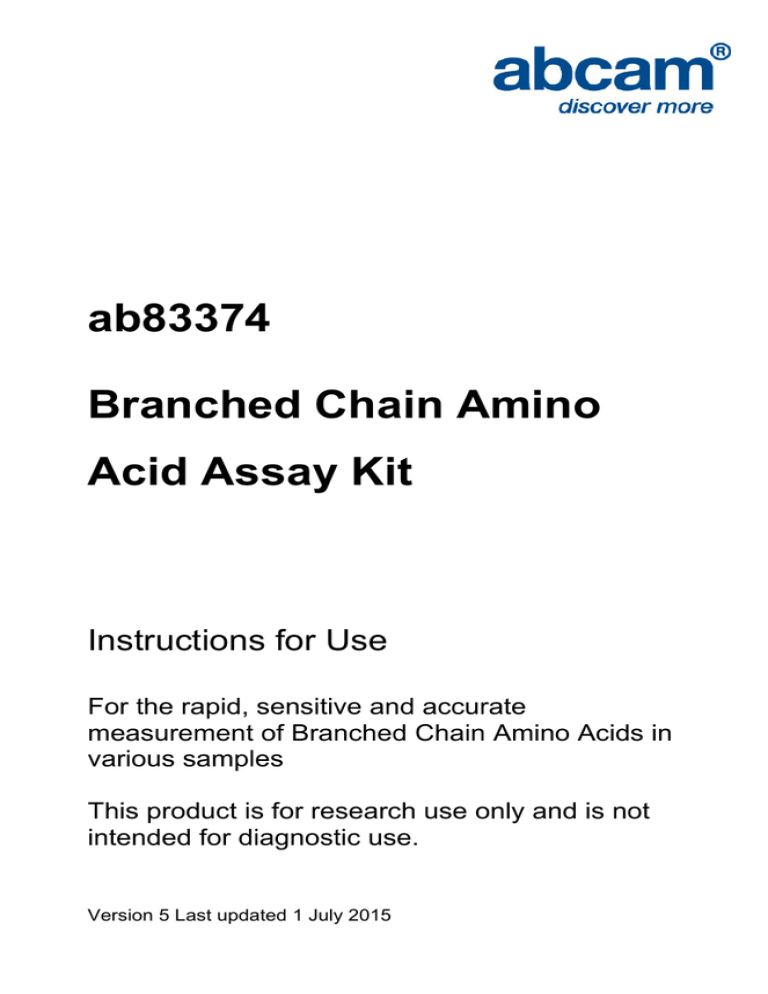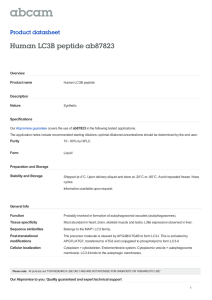
ab83374
Branched Chain Amino
Acid Assay Kit
Instructions for Use
For the rapid, sensitive and accurate
measurement of Branched Chain Amino Acids in
various samples
This product is for research use only and is not
intended for diagnostic use.
Version 5 Last updated 1 July 2015
Table of Contents
1.
Overview
3
2.
Protocol Summary
4
3.
Components and Storage
4
4.
Assay Protocol
6
5.
Data Analysis
9
6.
Troubleshooting
10
1
1. Overview
The branched-chain amino acids or BCAAs, refer to the amino acids
with non-linear aliphatic side-chains, namely leucine, isoleucine and
valine. These three essential amino acids make up approximately
1/3 of skeletal muscle in the human body. BCAAs are currently used
clinically to aid in the recovery of burn victims, as well as for strength
supplementation for athletes. BCAAs, primarily Leu, can stimulate
insulin secretion. The BCAAs have also been implicated in a wide
range of other physiological effects.
Abcam's Branched Chain Amino Acid Assay Kit provides a simple
convenient means of measuring the BCAA’s in a variety of biological
samples. The kit utilizes an enzyme assay in which BCAA is
oxidatively deaminated, producing NADH which reduces the probe,
generating a colored product (λmax = 450 nm). Abcam's Branched
Chain Amino Acid Assay Kit measures BCAAs in the range of 0 to
10 nmol per sample with a detection limit of ~0.2 nmol (~10 µM
BCAA in sample). BCAAs are present in serum ~0.1-0.4 mM each
(~0.125-1.5 mM combined).
2
2. Protocol Summary
Sample Preparation
Standard Curve Preparation
Prepare and Add Reaction Mix
Measure Optical Density
3
3. Components and Storage
A. Kit Components
Item
BCAA Assay Buffer
Quantity
25 mL
BCAA Enzyme Mix (Lyophilized)
1 vial
WST Substrate Mix (Lyophilized)
1 vial
Leu Standard (1 µmol)
100 µL
* Store the kit at -20°C, protect from light. Allow Assay Buffer to
warm to room temperature before use. Briefly centrifuge vials prior to
opening. Read the entire protocol before performing the assay.
BCAA ENZYME MIX: Dissolve with 220 μL BCAA Assay Buffer.
Pipette up and down to dissolve. Stable at 4°C for two months.
WST SUBSTRATE MIX: Dissolve with 220 μL of dH2O before use.
Mix well, store at 4°C, protect from light. Stable for 2 months.
LEUCINE STANDARD: Ready to use as supplied. Store at 4°C.
4
B. Additional Materials Required
Microcentrifuge
Pipettes and pipette tips
Colorimetric microplate reader
96 well plate
Orbital shaker
5
4. Assay Protocol
1. Sample Preparation:
Tissue (40 mg) or cells (4 x 106) can be homogenized with 200 μL
assay buffer. Centrifuge at 15,000 x g for 10 min to remove cell
debris and other insoluble materials.
As a guide, 0.02-0.5 mg of tissue lysates (protein) can be added per
well.
We recommend to test cell lysate samples in the range of 0.1-1x106
cells/well.
Add samples to sample wells in a 96-well plate and bring the volume
to 50 μL/well with assay buffer.
Typical volume for serum samples should be in the range of 1-20 μL.
We suggest testing several doses of your sample to make sure the
readings are within the standard curve range. We recommend to run
background controls (pg 7) for all samples.
2. Standard Curve Preparation:
Dilute 10 μL of the 10 mM Leucine Standard with 90 μL dH2O to
generate 1 mM Leucine standard. Add 0, 2, 4, 6, 8, 10 μL of the
diluted Standard into a 96-well plate to generate 0, 2, 4, 6, 8,
10 nmol/well standard. Bring the volume to 50 μL with Assay Buffer.
6
3. Reaction Mix: Mix enough reagents for the number of assays to
be performed. For each well, prepare a total 50 μL Reaction Mix
containing:
Amino Acid Measurement
Bkgd Control
Assay Buffer
46 μL
48 μL
Enzyme Mix
2 μL
---
WST Substrate Mix
2 μL
2 μL
4. Add 50 μL of the Reaction Mix to each well containing the leucine
standard and test samples. Mix well. Incubate the reaction for 30 min
at room temperature, protect from light.
Note:
NADH and NADPH can generate significant background. If these
compounds are suspected of being in your sample at significant
concentration, perform a simple background control by replacing the
Enzyme Mix with 2 μL Assay Buffer. The background reading should
be subtracted from the BCAA test sample readings.
5. Measure OD at 450 nm in a microplate reader.
7
5. Data Analysis
Correct background by subtracting the value derived from the zero
BCAA standards from all readings. The background reading can be
significant and must be subtracted from sample readings.
Plot the standard curve. Apply sample readings to the standard
curve.
BCAA concentrations of the test samples can then be calculated:
Concentration = Sa / Sv (nmol/μL, or mM)
Where:
Sa is BCAA content of unknown samples (nmol) from standard curve
Sv is sample volume (μL) added into the assay wells
BCAA molecular weights are: Leu 131.18, Ile 131.18, Val
117.15 g/mol.
8
Leucine Assay performed according to this protocol
9
6. Troubleshooting
Problem
Reason
Solution
Assay not
working
Assay buffer at
wrong temperature
Assay buffer must not be chilled
- needs to be at RT
Protocol step missed
Plate read at
incorrect wavelength
Unsuitable microtiter
plate for assay
Unexpected
results
Re-read and follow the protocol
exactly
Ensure you are using
appropriate reader and filter
settings (refer to datasheet)
Fluorescence: Black plates
(clear bottoms);
Luminescence: White plates;
Colorimetry: Clear plates.
If critical, datasheet will indicate
whether to use flat- or U-shaped
wells
Measured at wrong
wavelength
Use appropriate reader and filter
settings described in datasheet
Samples contain
impeding substances
Unsuitable sample
type
Sample readings are
outside linear range
Troubleshoot and also consider
deproteinizing samples
Use recommended samples
types as listed on the datasheet
Concentrate/ dilute samples to
be in linear range
10
Samples
with
inconsistent
readings
Unsuitable sample
type
Samples prepared in
the wrong buffer
Samples not
deproteinized (if
indicated on
datasheet)
Cell/ tissue samples
not sufficiently
homogenized
Too many freezethaw cycles
Samples contain
impeding substances
Samples are too old
or incorrectly stored
Lower/
Higher
readings in
samples
and
standards
Not fully thawed kit
components
Out-of-date kit or
incorrectly stored
reagents
Reagents sitting for
extended periods on
ice
Incorrect incubation
time/ temperature
Incorrect amounts
used
Refer to datasheet for details
about incompatible samples
Use the assay buffer provided
(or refer to datasheet for
instructions)
Use the 10kDa spin column
(ab93349)
Increase sonication time/
number of strokes with the
Dounce homogenizer
Aliquot samples to reduce the
number of freeze-thaw cycles
Troubleshoot and also consider
deproteinizing samples
Use freshly made samples and
store at recommended
temperature until use
Wait for components to thaw
completely and gently mix prior
use
Always check expiry date and
store kit components as
recommended on the datasheet
Try to prepare a fresh reaction
mix prior to each use
Refer to datasheet for
recommended incubation time
and/ or temperature
Check pipette is calibrated
correctly (always use smallest
volume pipette that can pipette
entire volume)
11
Problem
Reason
Solution
Standard
curve is not
linear
Not fully thawed kit
components
Wait for components to thaw
completely and gently mix prior
use
Pipetting errors when
setting up the
standard curve
Incorrect pipetting
when preparing the
reaction mix
Air bubbles in wells
Concentration of
standard stock
incorrect
Errors in standard
curve calculations
Use of other
reagents than those
provided with the kit
Try not to pipette too small
volumes
Always prepare a master mix
Air bubbles will interfere with
readings; try to avoid producing
air bubbles and always remove
bubbles prior to reading plates
Recheck datasheet for
recommended concentrations of
standard stocks
Refer to datasheet and re-check
the calculations
Use fresh components from the
same kit
For further technical questions please do not hesitate to
contact us by email (technical@abcam.com) or phone (select
“contact us” on www.abcam.com for the phone number for
your region).
12
13
14
UK, EU and ROW
Email: technical@abcam.com | Tel: +44-(0)1223-696000
Austria
Email: wissenschaftlicherdienst@abcam.com | Tel: 019-288-259
France
Email: supportscientifique@abcam.com | Tel: 01-46-94-62-96
Germany
Email: wissenschaftlicherdienst@abcam.com | Tel: 030-896-779-154
Spain
Email: soportecientifico@abcam.com | Tel: 911-146-554
Switzerland
Email: technical@abcam.com
Tel (Deutsch): 0435-016-424 | Tel (Français): 0615-000-530
US and Latin America
Email: us.technical@abcam.com | Tel: 888-77-ABCAM (22226)
Canada
Email: ca.technical@abcam.com | Tel: 877-749-8807
China and Asia Pacific
Email: hk.technical@abcam.com | Tel: 108008523689 (中國聯通)
Japan
Email: technical@abcam.co.jp | Tel: +81-(0)3-6231-0940
www.abcam.com | www.abcam.cn | www.abcam.co.jp
15
Copyright © 2015 Abcam, All Rights Reserved. The Abcam logo is a registered trademark.
All information / detail is correct at time of going to print.


![Anti-DR4 antibody [B-N28] ab59481 Product datasheet Overview Product name](http://s2.studylib.net/store/data/012243732_1-814f8e7937583497bf6c17c5045207f8-300x300.png)
![Anti-FAT antibody [Fat1-3D7/1] ab14381 Product datasheet Overview Product name](http://s2.studylib.net/store/data/012096519_1-dc4c5ceaa7bf942624e70004842e84cc-300x300.png)
